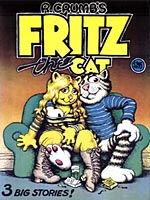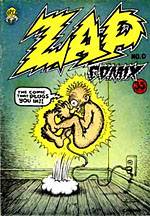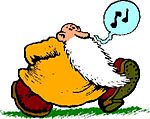
EARLY DAYS
Robert Crumb was born in Philadelphia on August 30, 1943. Crumb's interest in producing comics was obvious from an early age, when he used to make his own. Initially these were storyboarded by his brother Charles, but when Robert's own artistic skills began to develop, he took over the drawing.
One of the first characters he invented was an anthropomorphic take on their family pet, Fred the Cat. This character would eventually form the basis of one of Crumb's best-known characters, Fritz the Cat.
A traumatic upbringing, with family fights and parental bullying all too common, left scars both physical and mental on Crumb and his four siblings, which manifested as an extremely dark and embittered subtext running through most of Crumb's subsequent work.
LANDMARKS
 1962 - Crumb left home for a job in Cleveland, Ohio, where he worked as a greeting card artist and learned much of his trade as a draughtsman. Continuing to work on his comics concurrent with this job, he submitted one to the public gallery section of MAD founder Harvey Kurtzman's magazine, HELP. Kurtzman recognised the young man's talent and became a mentor figure to him.
1962 - Crumb left home for a job in Cleveland, Ohio, where he worked as a greeting card artist and learned much of his trade as a draughtsman. Continuing to work on his comics concurrent with this job, he submitted one to the public gallery section of MAD founder Harvey Kurtzman's magazine, HELP. Kurtzman recognised the young man's talent and became a mentor figure to him.
Crumb moved to New York at Kurtzman's behest to work on HELP, but the magazine folded just after Crumb returned from an eight-month stay in Europe. Crumb stayed on in New York to find more work, including a period making comics trading cards for Topps Gum. He found little else, and eventually returned to Cleveland.
1964 - Crumb married his first wife, Dana Morgan. Around this time he also created the first version of FRITZ THE CAT for Cavalier magazine.
1965 - Crumb took LSD for the first time. This would have a lasting influence on all his work. He noted that the mental legacy far outlasted the physical reaction to the drug. His exposure to the hallucinogen provoked intensely surreal flights of fantasy that resulted in the creation of some of his most famous characters, including Mr Natural, Flakey Foont, and the Vulture Demonesses.
January 1967 - After accepting a lift from friends bound for San Francisco, Crumb found himself in California, where he created some strips for the East Village Other and a magazine called Yarrowstalks. However, the prevailing atmosphere at the time was the booming hippie counterculture of the Haight-Ashbury scene, and Crumb soon decided that the time was ripe to produce comic book material that would appeal to this culture - Underground comix.
His original publisher for ZAP COMIX disappeared with his original artwork, so Crumb had to publish the material he had produced for the second issue first. Thankfully, he had retained xeroxes of his stolen artwork, and found a willing and trustworthy new publisher, so the stolen material was published as #0.
 1969 - ZAP COMIX was practically an overnight success, and it was soon attracting other underground cartoonists like S Clay Wilson, Rick Griffin and Victor Moscoso as contributors. However, events took a sour turn for Crumb when a strip in ZAP #4 called 'Joe Blow', featuring depictions of incest, saw several comics stores busted and charged under obscenity laws.
1969 - ZAP COMIX was practically an overnight success, and it was soon attracting other underground cartoonists like S Clay Wilson, Rick Griffin and Victor Moscoso as contributors. However, events took a sour turn for Crumb when a strip in ZAP #4 called 'Joe Blow', featuring depictions of incest, saw several comics stores busted and charged under obscenity laws.
1970 - Crumb's rising popularity was reflected by collections of his earlier work by the likes of Ballentine Books, which produced a FRITZ THE CAT collected edition. Based on this book, the animator Ralph Bakshi took an interest in the character. Crumb was reluctant to allow his work to be adapted into an animated feature, so Bakshi negotiated with Crumb's wife Dana, who Crumb later claimed sold the rights to FRITZ without his consent.
Bakshi's FRITZ THE CAT was the first X-rated feature-length cartoon. Although the film grossed more than thirty million dollars, Crumb was so disappointed with the finished result that he disowned it. He then killed Fritz off in an unsuccessful attempt to prevent a sequel being made.
1972 - Crumb's other major passion besides comics was music, so in 1972 he formed a blues, jazz and string band called The Cheap Suit Serenaders. Another member of the band was filmmaker Terry Zwigoff, who would later produce a biopic about his friend entitled CRUMB.
1976 - Crumb's popularity as a counterculture figurehead had reached the point where the public were more interested in him as a personality than in his work. He was even invited to host Saturday Night Live, but, reluctant to face that degree of exposure, he declined.
1977 - Something of an annus horribilis for Crumb. First, he was faced with a legal challenge to his royalties on his widely-reproduced 'Keep On Truckin' motif. A federal judge ruled that, as Crumb had never registered copyright, the image was in the public domain, so a substantial portion of Crumb's royalty payments dried up. It was also the year in which he divorced his first wife Dana, and fled to France to postpone payment on a $30,000 tax bill.
1978 - Crumb enjoyed something of a fresh start in 1978, as he married Aline Kominsky, a noted San Francisco cartoonist, and resolved his financial difficulties enough to be able to return to California.
 1981 - With the assistance of Kominsky, Crumb created a new anthology magazine, WEIRDO. This was a showcase not just for his own work, but also for a new generation of underground and 'fringe' cartoonists. 1981 also saw the birth of his daughter Sophie.
1981 - With the assistance of Kominsky, Crumb created a new anthology magazine, WEIRDO. This was a showcase not just for his own work, but also for a new generation of underground and 'fringe' cartoonists. 1981 also saw the birth of his daughter Sophie.
The 80s proved a fecund but rather unremarkable period for Crumb and his comics output. However, his artistic legitimacy was recognised to the extent that he was profiled by the likes of Newsweek, People and the BBC; he was, perhaps, as close as he would get to the mainstream.
1990 - Crumb's critical reputation was such that he was featured prominently in an exhibition called 'High and Low' at the New York Museum of Modern Art.
1993 - Increasingly disillusioned with life in the United States, and unimpressed what he regarded as a highly conservative era, Crumb, Kominsky and their daughter relocated to the south of France. His status and the value placed on his work were such that he was able to buy a villa by selling six of his old notebooks.
1995 - Terry Zwigoff's biopic CRUMB was released, to widespread critical acclaim. It even won the Grand Jury Prize at the Sundance Film Festival. CRUMB focused largely on Crumb's relationship with his siblings, particularly his brother Charles, who had been mentally ill since his teenage years. The scenes featuring the two of them in conversation were given a particularly poignant resonance by the fact that Charles committed suicide not long after the film was completed.
LATTER DAYS
Crumb continues to produce new work, such as illustrated adaptations of the writings of Charles Bukowski, and books covering such familiar Crumb territory as MY TROUBLES WITH WOMEN. However, recent releases have primarily taken the form of Fantagraphics' comprehensive reprints series THE COMPLETE CRUMB. His sketchbooks are also currently being published.
FURTHER READING:
Comic Strip Pioneers: Robert Crumb
Comic Art & Graffix Gallery Artist Biographies on Robert Crumb
R C Harvey on Robert Crumb
THE LIFE AND DEATH OF FRITZ THE CAT (1993): The Fantagraphics collection of that lecherous and immoral feline's misadventures contains all the themes and motifs that characterise Crumb's work. Alternately lustful and misogynistic, it represents a dysfunctional view of the world of an underground lowlife, as seen by the eponymous and philandering cat himself. It's also notable for containing the story in which Crumb ruthlessly killed off Fritz.
THE COMPLETE CRUMB (1990 - present): A definitive look at the entire body of published work Crumb has produced, organised chronologically and featuring much of his more obscure work. All the well-known favourites are included, and each of the many volumes has an introduction by Crumb himself. Invaluable to the Crumb enthusiast.
CRUMB ON CRUMB
"[Taking LSD] was a once-in-a-lifetime experience - like a religious vision that changes someone's life, but in my case it was the psychotic manifestation of some grimy part of America's collective unconscious." [From an interview with Gary Groth in THE COMICS JOURNAL, as quoted at The Official RC Harvey Homepage.]
"The first issue [of ZAP COMIX] was printed in February 1968. We folded and stapled all 5,000 copies ourselves and took them out and sold them on the street out of a baby carriage. At first, the hippie shopkeepers on Haight Street looked down their noses at it - 'A comic book? No, I don't like comic books.' It looked just like a traditional comic book. It had none of the stylings of your typical psychedelic graphics - the romantic figures, the curvy, flowing shapes. It took a while to catch on." [ibid.]

This article is Ideological Freeware. The author grants permission for its reproduction and redistribution by private individuals on condition that the author and source of the article are clearly shown, no charge is made, and the whole article is reproduced intact, including this notice.


